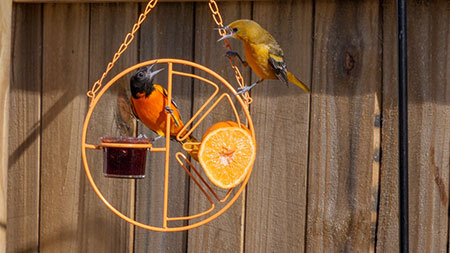April 22, 2020

An adult male and an immature Baltimore oriole look as if they're talking about a sweet treat from a feeder in North Charleston. (Photo by David Ramage)
South Carolina's 2020 Baltimore Oriole Winter Survey reported the largest number of orioles wintering in the United States for the sixth year in a row.
Those results were recorded during the sixth annual Baltimore Oriole Winter Survey, conducted by the S.C. Department of Natural Resources (SCDNR) Feb. 14-17, 2020.
SCDNR's survey was held in conjunction with the Great Backyard Bird Count (GBBC). Tapping into this long standing citizen-science project allowed SCDNR to get a better picture of the status and distribution of this beautiful songbird wintering in the Palmetto State.
Survey participants in South Carolina submitted 88 reports and recorded 401 orioles. The number of reports was South Carolina's highest number to date, and the number of orioles recorded was the third highest to date. The number of participants this year was South Carolina's highest number to date, and 60% of those were new to the survey.
Weather this year was a little more seasonable than in recent years. A weather system moved through the state during the survey period, and likely caused oriole activity to increase at the feeders.
Participants counted and reported the largest number of orioles they could see at one time, on one, two, three or all four days of the survey period. When possible, the age and sex of the orioles were recorded as well. Participants were also encouraged to report the absence of orioles, when they have had them in past winters and the largest number they have seen at one time so far, during the winter months, (December, January and February). Reporting the absence of orioles is just as important to the survey as the number of orioles seen.
This year, orioles were reported from 14 of the 22 South Carolina counties that have been reported to date. Two counties, Anderson and Greenwood, had a report for the first time during the survey. Orioles ranged from the Midlands and throughout the coastal plain, from North Myrtle Beach to Hilton Head. Charleston County had the most reports and recorded the largest number of orioles, reporting 38% of the total number of orioles in the state. Berkeley, Charleston and Dorchester counties were the top reporting counties for participants and orioles seen. This tri-county area made up 68% of the reports and 67% of orioles seen.
According to the GBBC and the SCDNR survey, a total of 302 reports and 976 orioles were recorded this year in the United States. South Carolina had the second largest number of reports in the United States and the largest number of orioles seen. Orioles were reported from New Hampshire to Florida and along the Gulf coast to Texas. There was also a report of an oriole in Newfoundland this year. Coastal states, from Virginia to Florida, had 95% of the total number of reports and 98% of the total orioles seen.
Baltimore orioles are neotropical migrants, normally wintering in South and Central America and migrating to North America to nest. During the last several decades, however, this species has begun wintering annually in the Southeast. Though scientists are not sure why these birds have begun overwintering in growing numbers, the birds respond well to the popularity of backyard bird feeding.
Orioles by nature have a "sweet tooth" and will eat nectar from flowers, wild fruits and insects. Their favorite bird-feeding food by far is grape jelly. Orange halves can be offered, but most orioles tend not to eat them much. People often put oranges out to attract the orioles to the feeding area. Other items orioles will eat are suet products (homemade, cakes, bark butter, logs, etc.), sugar water (they will drink from hummingbird or oriole nectar feeders), seed mixes (seem to prefer nut and fruit mixes), sliced grapes and mealworms (live or freeze-dried).
"We would like to thank everyone that participated in the survey," said Lex Glover, wildlife technician with the SCDNR Bird Conservation Program. "Your time and efforts are greatly appreciated."
Next year's SCDNR Baltimore Oriole Winter Survey and Great Backyard Bird Count will be Feb. 12-15, 2021. If you have orioles frequenting your feeders during the winter months, (December, January and February), or know someone who does, SCDNR would like for you to participate in the survey. For more information on the Baltimore Oriole Winter Survey or to receive this year's survey results, contact Lex Glover.



